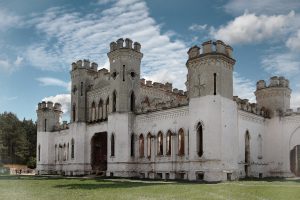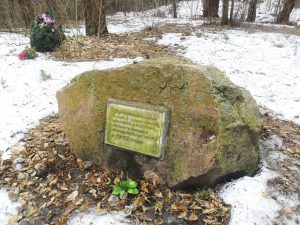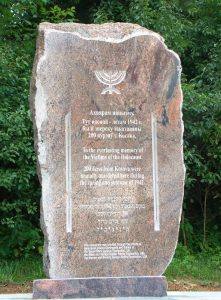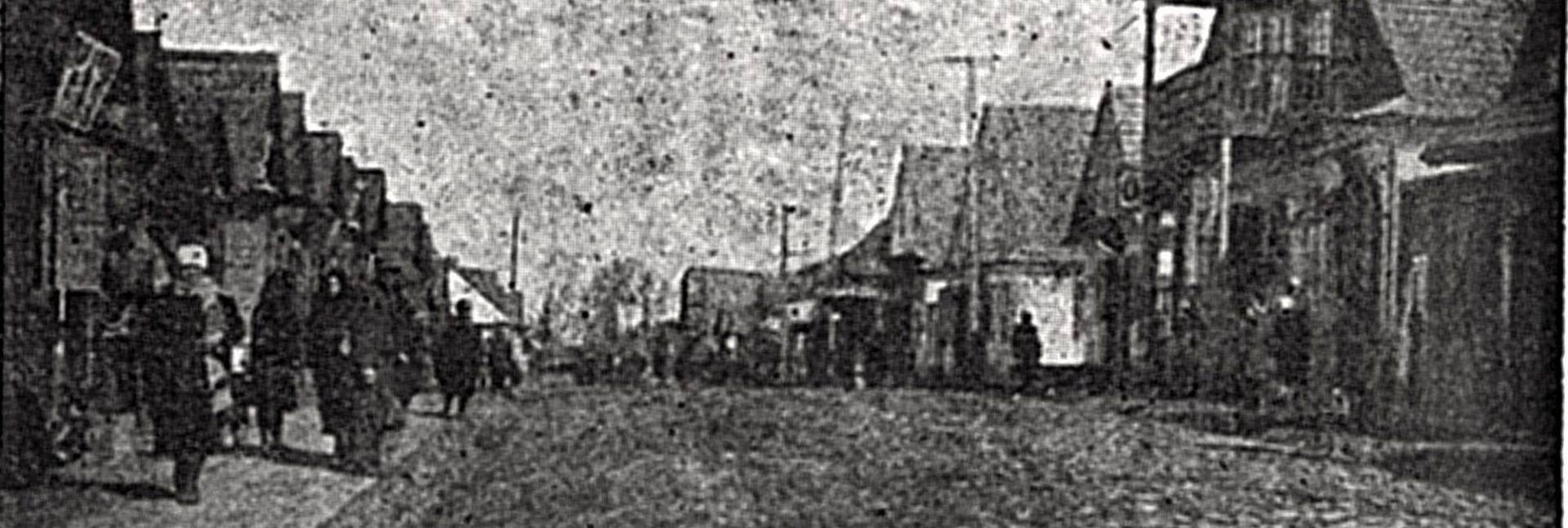The Nazis invaded the area near Kosów Poleski in 1941, however until June of that year Kosów Poleski remained in a pocket of Soviet control, surrounded by areas of Nazi control. In June the Nazis shelled Kosów Poleski and many houses were destroyed by fire. On July 1, 1941, the Nazis advanced and took control of the town and mandated that all Jews wear yellow stars. When the residents did not cooperate, the Germans publicly executed the Jews who were responsible for the community. The deadline for wearing yellow stars was extended to July 14 and a nine-member Judenrat was established. The Judenrat was charged with collecting a heavy ransom (2.2kg/4lb of gold). Much of the livestock was confiscated and 22 town dignitaries were arrested; the Judenrat was able to get ten of the dignitaries released by delivering a large sum of money but the other twelve were executed.
Jews from the surrounding area were delivered to Kosów Poleski and by Occtober 1941 the Jewish population was 2,250. In the winter of 1941-42, 300 young people were sent to work on the paving of a road in Slonim (42km/26mi to the north). They continued working there until Passover 1942. Later they were reassigned to a work camp at Kozłowszczyzna (another 26km/16mi further north from Slonim) and 300 additional workers from Kosów Poleski were sent to Slonim to take their place. That same spring (1942) someone told the Germans that there were partisans among the Jews of Kosów Poleski and thirteen were arrested: six were released after paying off the Germans but the other seven were executed. People tried to go from Kosów Poleski to nearby Rózana (Ruzhany) because it was in another district and they believed that the treatment there was less harsh. Many of them were discovered and executed.

In June of 1942, three ghettos were established. One was right in the town, enclosed with barbed wire, where skilled workers and their families were detained. A second ghetto was set up at the Puslowski Palace in Mereczowszczyzna for the old and those who were unable to perform labor. A third ghetto was set up on a adjacent estate for the family of those doing forced lablor in Slonim or at the Kozłowszczyzna camp; this was called the “Court” ghetto in the Memorial Book of Kosów Poleski. These latter two ghettos were open (no barbed wire or fences). Between 6AM and 6PM people in these two ghettos were able to move between them. They were fed 250g/8oz of bread per person per day. In June 1942 the Kozłowszczyzna camp was attacked by Soviet partisans who freed the workers. Most of the ones from Kosów Poleski returned to the town.
On July 19, 1942 the Germans stopped sending the Jews to perform labor and the ghettos were besieged. Tisha b’Av fell on Thursday July 23, 1942. The Jews fasted and believed that if they made it through the day, things would improve. It became apparent the next day, July 24, 1942, that terrible things were about to happen. All the patients in the Jewish hospital were murdered by the Germans. After the commencement of Sabbath prayers at the “Court” ghetto, Ukrainian police entered and told them that no one could leave the room, they could not use the bathroom nor could they look out the windows: they all stayed on the floor below the level of the windows. Through the night two Ukrainian police threatened the Jews and tried to obtain their valuables while a third Ukrainian policeman kept watch outside as the Germans would want the loot for themselves. During this time the Jews at the Puslowski castle ghetto, about 500 people, were slaughtered and their bodies placed in ditches previously used for potato storage. (Another account describes locals digging a large pit, 20m square, for this purpose.)

Around 9AM on Saturday, July 25, 1942 a Germans sergeant arrived at the “Court” ghetto and the Ukrainians stopped their action. An hour later three cars and seven trucks came. The Jews, about 600, were lined up and any shoemakers and tailors were asked to step out of the lines. Local troops assisted torturing and kicking the remainder of the Jews who were then ordered into the trucks. Those who could climbed in and the others were stacked on top of them, several layers deep in the trucks — everyone’s faces towards the floor. The people on the bottom were suffocated and if anyone higher up tried to lift his or her head, the local troops used their boots to smash down that person’s head. All the bodies were taken to Mereczowszczyzna and added to those already in the pits.
The artisans were transported to the closed ghetto in the town and they observed the same cruelty that had taken place at the “Court” ghetto. There were two large boxes into which the Jews were to deposit all their gold and money. The Ukrainians went wild here as well and searched for Jews in their hiding places. Those who were found were taken directly to the trucks and then to the pits near the castle.
The craftsmen remained in town while the Germans officers were seated and got drunk. Four young Jewish women were brought in, forced to remove all their clothes and were humiliated in front of the craftsmen. The women were then shot. Then the wives of some of the craftsmen were brought forward and similar humiliations occurred. All the dead women’s bodies were taken to Mereczowszczyzna.

Two hundred other people hid in the attic of the Tarbut school through the evening of the slaughter. The following day, the head of the police came to them and told them that they could come out and that nothing bad would happen to them. Indeed, they were permitted to leave and formed a new ghetto that was not guarded. They lived there for over a week until August 2, 1942 when Soviet partisans attacked. At the end of a four-hour battle, the partisans prevailed and took all of the Jews with them. When they left town they realized that they had too many people. They told the old people to return to town and they only took the young ones with them. The German police ordered the ones who returned to dig their own graves. After that the Germans killed them all. Other accounts of this event say it occurred in September. The the Germans were able to round up 200 people and they were shot at Yalovasto. A marker there commemorates these deaths.
The 31 craftsman who were spared on the day of the slaughter were taken to Mereczowszczyzna to the large mass grave. There, they saw how the peasants were collecting and piling up all of the clothes of those that were killed. The craftsmen were sent to the Smolensk camp, where they were to work in their professions. Subsequently all but one of them was murdered or succumbed to disease as a result of the conditions in the several concentration camps in which they were held. By Passover 1944 (April), only one craftsman survived. He told what he witnessed in the Memorial Book of Kosów Poleski.
On June 11, 1944, the Soviet 19th Mechanized Brigade of the 28th Army liberated Kosów Poleski. 26 Jews survived. In March 1945 the Soviet Extraordinary State Commission concluded that at least 1,925 people had been killed in Kossovo during the occupation. The report did not specify the nationality of the victims. in total, 1,726 civilians were killed, mostly women, children and the elderly. These final statistics come primarily from Encyclopedia of Camps and Ghettos, 1933-1945.
The photos below commemorate many people who were killed in the Holocaust. Clicking on a photo below will show an enlarged version, sometimes with detailed captions identifying people in the photo.
Resources
The entire text of the Memorial Book of Kosów Poleski has been translated into English (from Hebrew) and is available online for free.
The United States Holocaust Memorial Museum’s book, Encyclopedia of Camps and Ghettos, 1933–1945, provides a great deal of information about the Holocaust. In Volume 2, there is a description of the events that took place in Kosów Poleski. That institution makes a PDF of the book available for free to researchers.
